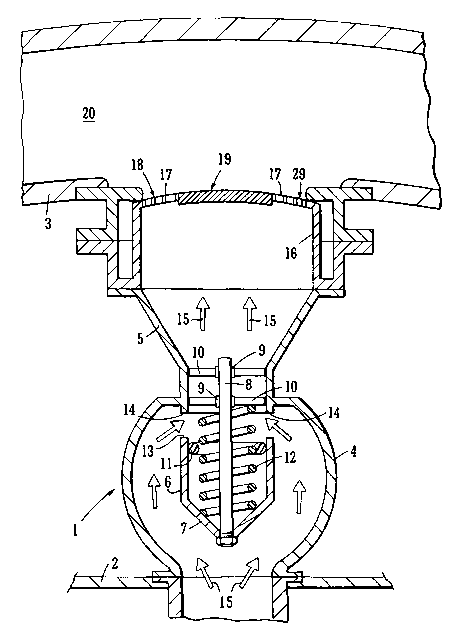Une partie des informations de ce site Web a été fournie par des sources externes. Le gouvernement du Canada n'assume aucune responsabilité concernant la précision, l'actualité ou la fiabilité des informations fournies par les sources externes. Les utilisateurs qui désirent employer cette information devraient consulter directement la source des informations. Le contenu fourni par les sources externes n'est pas assujetti aux exigences sur les langues officielles, la protection des renseignements personnels et l'accessibilité.
L'apparition de différences dans le texte et l'image des Revendications et de l'Abrégé dépend du moment auquel le document est publié. Les textes des Revendications et de l'Abrégé sont affichés :
| (12) Demande de brevet: | (11) CA 2468141 |
|---|---|
| (54) Titre français: | DISPOSITIF D'ATTENUATION DE BRUIT |
| (54) Titre anglais: | NOISE ATTENUATOR ARRANGEMENT |
| Statut: | Réputée abandonnée et au-delà du délai pour le rétablissement - en attente de la réponse à l’avis de communication rejetée |
| (51) Classification internationale des brevets (CIB): |
|
|---|---|
| (72) Inventeurs : |
|
| (73) Titulaires : |
|
| (71) Demandeurs : |
|
| (74) Agent: | ROBIC AGENCE PI S.E.C./ROBIC IP AGENCY LP |
| (74) Co-agent: | |
| (45) Délivré: | |
| (86) Date de dépôt PCT: | 2002-11-20 |
| (87) Mise à la disponibilité du public: | 2003-06-05 |
| Licence disponible: | S.O. |
| Cédé au domaine public: | S.O. |
| (25) Langue des documents déposés: | Anglais |
| Traité de coopération en matière de brevets (PCT): | Oui |
|---|---|
| (86) Numéro de la demande PCT: | PCT/GB2002/005230 |
| (87) Numéro de publication internationale PCT: | GB2002005230 |
| (85) Entrée nationale: | 2004-05-19 |
| (30) Données de priorité de la demande: | |||||||||
|---|---|---|---|---|---|---|---|---|---|
|
L'invention concerne un appareil de libération de fluides sous pression, comprenant une ouverture (1) à travers laquelle peuvent passer les fluides sous pression et un élément (16) d'atténuation s'étendant au-dessus de ladite ouverture. L'élément (16) d'atténuation permet de régler le débit dudit fluide et d'atténuer le bruit associé.
Apparatus for the release of pressurised fluids comprising an opening (1)
through which pressurised fluids may pass and an attenuator member (16)
extending over said opening. The attenuator member (16) operates to control
the flow of said fluid and attenuate sound associated therewith.
Note : Les revendications sont présentées dans la langue officielle dans laquelle elles ont été soumises.
Note : Les descriptions sont présentées dans la langue officielle dans laquelle elles ont été soumises.

2024-08-01 : Dans le cadre de la transition vers les Brevets de nouvelle génération (BNG), la base de données sur les brevets canadiens (BDBC) contient désormais un Historique d'événement plus détaillé, qui reproduit le Journal des événements de notre nouvelle solution interne.
Veuillez noter que les événements débutant par « Inactive : » se réfèrent à des événements qui ne sont plus utilisés dans notre nouvelle solution interne.
Pour une meilleure compréhension de l'état de la demande ou brevet qui figure sur cette page, la rubrique Mise en garde , et les descriptions de Brevet , Historique d'événement , Taxes périodiques et Historique des paiements devraient être consultées.
| Description | Date |
|---|---|
| Demande non rétablie avant l'échéance | 2007-11-20 |
| Le délai pour l'annulation est expiré | 2007-11-20 |
| Réputée abandonnée - omission de répondre à un avis sur les taxes pour le maintien en état | 2006-11-20 |
| Inactive : CIB de MCD | 2006-03-12 |
| Lettre envoyée | 2005-06-13 |
| Inactive : Transfert individuel | 2005-05-16 |
| Inactive : Lettre de courtoisie - Preuve | 2004-09-28 |
| Inactive : Page couverture publiée | 2004-09-23 |
| Inactive : Notice - Entrée phase nat. - Pas de RE | 2004-09-21 |
| Demande reçue - PCT | 2004-06-23 |
| Exigences pour l'entrée dans la phase nationale - jugée conforme | 2004-05-19 |
| Demande publiée (accessible au public) | 2003-06-05 |
| Date d'abandonnement | Raison | Date de rétablissement |
|---|---|---|
| 2006-11-20 |
Le dernier paiement a été reçu le 2005-11-01
Avis : Si le paiement en totalité n'a pas été reçu au plus tard à la date indiquée, une taxe supplémentaire peut être imposée, soit une des taxes suivantes :
Les taxes sur les brevets sont ajustées au 1er janvier de chaque année. Les montants ci-dessus sont les montants actuels s'ils sont reçus au plus tard le 31 décembre de l'année en cours.
Veuillez vous référer à la page web des
taxes sur les brevets
de l'OPIC pour voir tous les montants actuels des taxes.
| Type de taxes | Anniversaire | Échéance | Date payée |
|---|---|---|---|
| Taxe nationale de base - générale | 2004-05-19 | ||
| TM (demande, 2e anniv.) - générale | 02 | 2004-11-22 | 2004-10-29 |
| Enregistrement d'un document | 2005-05-16 | ||
| TM (demande, 3e anniv.) - générale | 03 | 2005-11-21 | 2005-11-01 |
Les titulaires actuels et antérieures au dossier sont affichés en ordre alphabétique.
| Titulaires actuels au dossier |
|---|
| DUNLOP AEROSPACE LIMITED |
| Titulaires antérieures au dossier |
|---|
| ANDREW BRISTOW |
| DARREN HILLYER |
| KEVIN YEOMANS |